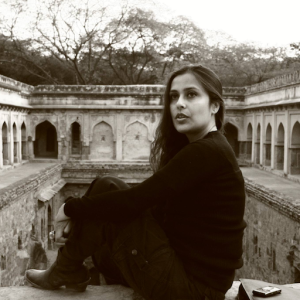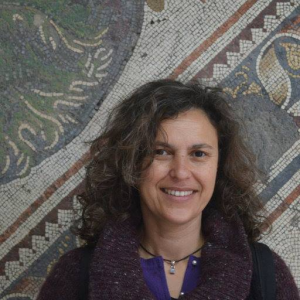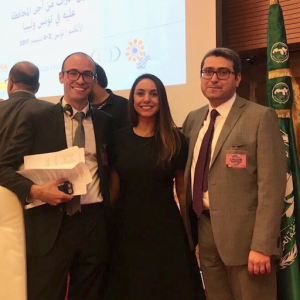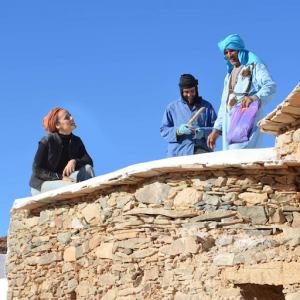On International Women’s Day 2018, the world celebrated the many contributions of women to the history and progress of humanity. At Global Heritage Fund, our celebrations are not limited to just one day. Women fill many of our roles — they are our staffers, collaborators, project leaders, program directors, international workers, interns, and consultants. Most importantly, they are vital to all aspects of our success.
Throughout the world, women are our politicians and our bankers, our baristas and our local grocery store clerks. They are the drivers of social revolutions and the innovators of countless developments in human history. Yet too often, the achievements of women are overlooked by history and society at large.
On International Women’s Day — March 8, 2018 — people around the world united to celebrate the many contributions of women to the history and progress of humanity. At Global Heritage Fund, we highlighted the special place women have in the preservation of our world’s most special, vulnerable places.
At every one of our projects, we use our unique Preservation by Design® methodology to assess the best way to preserve, protect, and promote a site and its surrounding communities. Much of this work relies on the expertise of local women, as both partners and stakeholders, whose perspectives inform and enrich our work. In fact, many of our projects would not be possible without the invaluable work of our Global Heritage Fund women.

Spotlight: Abha Lambha
Abha Lambha in India works diligently to make our plans for the preservation and promotion of her country’s second most visited tourist site: the spectacular Amer Fort of Jaipur in Rajasthan. Beyond her work with GHF, Abha is known for her restoration of the Mumbai Opera House, which reopened its doors in 2016 for the first time in 23 years after her extensive renovations.

Spotlight: Stefania Chlouveraki
Stefania Chlouveraki of the Technological Educational Institute of Athens has worked with Global Heritage Fund for several years to preserve the site of Ayios Vasileios in Greece. Containing invaluable Mycenaean artifacts including religious figurines, bronze weapons, and clay tablets inscribed with the earliest form of the Greek language ever recorded, Ayios Vasileios is often considered one of the most important archaeological finds of the last 20 years.
Women comprise a huge portion of our work. Our projects are interdisciplinary, involving heritage, conservation, architecture, archaeology, and restoration – to name just a few relevant fields. In many or even most of these fields, women are vastly underrepresented even today.
Consider art conservation, which frequently goes hand-in-hand with heritage preservation. The Association of Art Museum Directors (AAMD) reports that “female art-museum directors earn substantially less than their male counterparts, and upper-level positions are most often occupied by men.” Even worse, many of the museums run by women are those with the smallest budgets. Women are simply not to be found in leadership roles at the major, well-funded art museums. The New York Times reported that as recently as 2015, men headed all twelve of the world’s top art museums as calculated by attendance. Even more shockingly, the top three museums — the Louvre, the British Museum and the Metropolitan Museum of Art — have never been run by a woman.
Even in fields with more balanced gender ratios, women tend to be in lower-responsibility roles while men dominate the leadership positions, which are often times better paying and more prestigious. Consider archaeology, which has a growing number of female archaeologists, and in some countries, women even constitute a majority of the field. However, women continue to be underrepresented at the highest leadership and academic levels. Sue Hamilton at the Institute of Archaeology in the UK notes that “the issue is not the numerical under-representation of females in archaeology…[but] rather that of a continuing gender imbalance in the achievement of permanent employment (particularly in academia), in access to career progression, and in the achievement of higher-level positions and pay.” Women may be present, but they are far from earning the high levels and recognition that they deserve.
At Global Heritage Fund, we are proud to tell a different story. We believe it’s not just enough to talk about supporting women – we take action to actively involve women in our projects, at all levels. In the field, half of our project directors are women, and these talented contributors are the catalysts for our greatest successes. Our project directors are exploring parts of the world typically left out of guidebooks. Abha Lambha camps in the deserts of Rajastan, while Kuanghan Li visits unique parts of China that aren’t known internationally. The women like Abha and Kuanghan are pioneers in the field of heritage conservation, and we value their leadership on our projects.
Our organizational leadership is also comprised of many strong women. As a company based in the Silicon Valley, at the heart of the California Bay Area, we are acutely aware of the gender gap so prevalent in many local, high-profile companies. Men dominate Silicon Valley’s leadership roles. Women make up only 11% of executives and 10% of directors for Silicon Valley 150 Index companies, representing the largest companies by revenue. In contrast to this dismal statistic, fully one-third of our board is female. The women on our board are strong leaders, coming to us from organizations as diverse as the World Bank and San Francisco Art Institute.
In our office, over half of our staff are women, including our Development Manager, Programs Intern, Media Consultant, Office Manager, and Director of Projects, Programs and Partnerships. These many women staffers are vital to making GHF an effective force for global cultural heritage conservation.
 Spotlight: Nada Hosking
Spotlight: Nada Hosking
Beyond managing and building a roadmap for GHF projects and partnerships, Nada Hosking has been spearheading the development of a digital documentation platform for emergency management of cultural heritage. As the leader of our AMAL in Heritage program, Nada is helping create a solution for preparedness, response, and recovery from heritage disasters in the Middle East, North Africa, and eventually, the world.

Spotlight: Kuanghan Li
Our five China Heritage Program projects have ranged from Qing Dynasty-era temples to ancient Buddhist grottoes, but each has been united by one constant: the steadying hand of our project director, Ms. Kuanghan Li. Currently a Ph.D. candidate at Peking University in cultural heritage conservation, Han has been integral to the success of our past and current projects. We salute her many contributions to building a world that is truly beyond monuments.
We also make a special effort to empower some of the most vulnerable members of communities: local women. Our projects provide local women with the means to leverage their special places into tangible economic benefits. For the women of Dali Village in China, we are working with Studio ATLAS to build a co-op that will give them – and their beautiful textile arts – access to the international folk crafts market. In the rugged mountains of the Anti-Atlas in Morocco, we are partnering with Dr. Salima Naji and local communes to create venues around heritage sites for local products and terroir.

Spotlight: Dr. Salima Naji
The architect and cultural heritage preservationist Salima Naji has been the face of our work in Morocco, and we couldn’t ask for a better colleague and friend. Throughout her work, Dr. Naji conserves architecture and public spaces not only for their historic value, but as locally rooted, sustainable models for contemporary building. Transforming the communal granaries of Amtoudi from flood-destroyed ruins into beautiful communal structures once again, Dr. Naji and her work are symbols of the enduring power of our global cultural heritage.
We understand that involving women in our projects ensures that they will have a higher success rate. After all, women are integral for future conservation and the success of conservation projects. From nature conservation to cultural programs, we’ve learned that involving women in preservation projects is vital to their long-term success.
The importance of successful conservation projects cannot be overstated, as these projects are key to protecting heritage sites for future generations. There are also economic reasons for governments and organizations to care about heritage preservation; besides preserving history for posterity, heritage sites are invaluable for economically stimulating areas, drawing visitors interested in cultural experiences. As noted by the Organisation for Economic Co-operation and Development (OECD), cultural tourism is among the largest and fastest-growing sector of the larger global tourism industry, and the UNTWO predicts that cultural tourism will grow by fifteen percent in the coming years. Heritage sites are important tourist attractions, and thus, protecting heritage sites is vital to future economic growth.
At GHF, we protect the world’s most endangered heritage sites and celebrate the unique voices and perspectives women bring to our organization. Here are some ideas of how you can host your own celebration:
- Patronize women-owned or -operated businesses
- Seek out women-centered media, such as books, movies and music created by and about women
- Talk (and more importantly, listen!) to women in your life
- Become a monthly supporterof an organization working to empower women, like GHF
We encourage you to celebrate and reflect on the achievements of women in your life and in the world, as we have. However you choose to celebrate, we echo the words of Chelsea Clinton: “Particularly at this moment, in 2018, when we have so many women who are raising their voices around the world, so many women here in the United States who are running for office, my message is thank you and we have to keep going.” Keep going, ladies!

